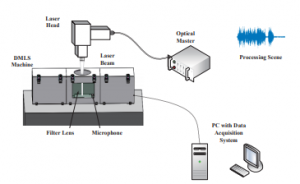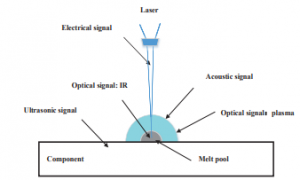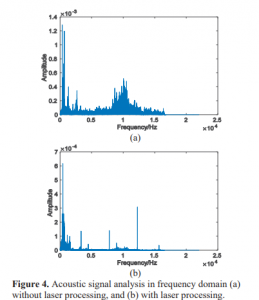 Metal 3D printing is constantly under study to improve its quality and repeatability. A new research paper focuses on direct metal laser sintering (DMLS), also known as selective laser melting (SLM) and Powder Bed Fusion for Metal. DMLS still has its shortcomings, which include delamination between base plates and inaccuracy among various orientations. The paper, entitled “Characterization of acoustic signals during a direct metal laser sintering process,” points out that sintered parts tend to still be relatively large, soft and porous, hampering their widespread use, so improving part quality and repetability is crucial, especially for industries like aerospace and medicine.
Metal 3D printing is constantly under study to improve its quality and repeatability. A new research paper focuses on direct metal laser sintering (DMLS), also known as selective laser melting (SLM) and Powder Bed Fusion for Metal. DMLS still has its shortcomings, which include delamination between base plates and inaccuracy among various orientations. The paper, entitled “Characterization of acoustic signals during a direct metal laser sintering process,” points out that sintered parts tend to still be relatively large, soft and porous, hampering their widespread use, so improving part quality and repetability is crucial, especially for industries like aerospace and medicine.
The researchers look at acoustic signal processing as a way to monitor the build quality of a 3D printed part while in progress.
“This paper reports the relationship between acoustic signals, laser power as well as its laser scanning speed,” the researchers state. “The variety of acoustic signal power spectrum density (PSD) is presented and then the mechanism of acoustic signal formation is elaborated. A good mapping between acoustic signals and laser parameters has been found during the DMLS process. This lays a good foundation for monitoring the process and quality by acoustic signal and will enhance the part quality during the powder-based laser sintering and melting processes in the future.”
 Several methods of in-process monitoring exist, such as optical, thermal, ultrasound and acoustic signals. Each has its drawbacks, but acoustic signals have been found to be an effective method as long as they are not disrupted by environmental noise. In this study, acoustic signals generated during the DMLS process were sampled and utilized for online monitoring.
Several methods of in-process monitoring exist, such as optical, thermal, ultrasound and acoustic signals. Each has its drawbacks, but acoustic signals have been found to be an effective method as long as they are not disrupted by environmental noise. In this study, acoustic signals generated during the DMLS process were sampled and utilized for online monitoring.
Acoustic signals in a DMLS process are generated by several factors, mostly by the vibration from the friction of flow medium with liquid or solid matter, as well as flow motion. The signals in this study were sampled by an electret condenser microphone and processed with MATLAB 2015b.
The results of the experiment showed that there was a good correlation between the laser frequency and laser power as well as the laser scanning speed and acoustic signals.
“Through the investigation of the acoustic signal, information on the laser scanning characteristics can be extracted,” the researchers explain. “The second frequency peak is more promising for detecting the laser scanning attributes.”
 The study showed that there was a good mapping between the acoustic signals and laser scanning status as well as the resulting laser sintering quality. These results, according to the researchers, will lead to future monitoring techniques for DMLS and provide a strong foundation for real-time control of metal printing processes.
The study showed that there was a good mapping between the acoustic signals and laser scanning status as well as the resulting laser sintering quality. These results, according to the researchers, will lead to future monitoring techniques for DMLS and provide a strong foundation for real-time control of metal printing processes.
“Future studies will be carried out on part qualities such as surface roughness, porosity, density and composition of the powder mixture interpreted via acoustic signals,” they conclude. “Defects can be predicted automatically for quality monitoring and feedback control.”
Studies like this one are important steps toward understanding what is happening during the metal 3D printing process, so that defects can be caught and avoided. Metal 3D printing is far from a perfect process, but the more technology is applied to understanding it, the more effective it will be.
Authors of the paper include Dongsen Ye, Yingjie Zhang, Kunpeng Zhu, Geok Soon Hong and Jerry Fuh Ying His.
Discuss this and other 3D printing topics at 3DPrintBoard.com or share your thoughts below.
Subscribe to Our Email Newsletter
Stay up-to-date on all the latest news from the 3D printing industry and receive information and offers from third party vendors.
You May Also Like
Profiling a Construction 3D Printing Pioneer: US Army Corps of Engineers’ Megan Kreiger
The world of construction 3D printing is still so new that the true experts can probably be counted on two hands. Among them is Megan Kreiger, Portfolio Manager of Additive...
US Army Corps of Engineers Taps Lincoln Electric & Eaton for Largest 3D Printed US Civil Works Part
The Soo Locks sit on the US-Canadian border, enabling maritime travel between Lake Superior and Lake Huron, from which ships can reach the rest of the Great Lakes. Crafts carrying...
Construction 3D Printing CEO Reflects on Being Female in Construction
Natalie Wadley, CEO of ChangeMaker3D, could hear the words of her daughter sitting next to her resounding in her head. “Mum, MUM, you’ve won!” Wadley had just won the prestigious...
1Print to Commercialize 3D Printed Coastal Resilience Solutions
1Print, a company that specializes in deploying additive construction (AC) for infrastructure projects, has entered an agreement with the University of Miami (UM) to accelerate commercialization of the SEAHIVE shoreline...





























